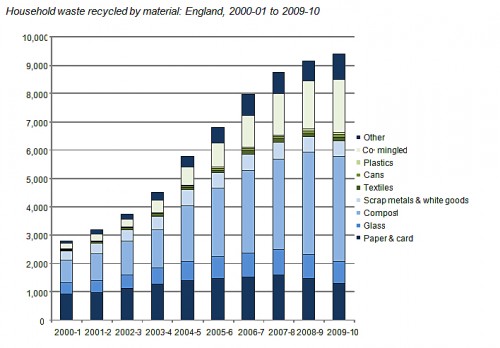You are here:
Home > Statistics > Environment and wildlife statistics > Waste and recycling > Household waste recycling, by material – England
Household waste recycling, by material – England
There has been a 235 per cent increase in household recycling in England between 2000-01 and 2009-10 and a 365 per cent increase in green recycling alone.
Why is this important – The EU Waste Framework Directive requires the UK to recycle, compost or reuse 50 per cent of waste from households by 2020.
- In 2009-10 England generated 23 million tonnes of household waste 9.4 million tonnes (39.7 per cent) of this was sent for recycling, composting or reuse. This compares with 2000-01 when 25 million tonnes of household waste was generated and 2.9 million (11.2 per cent) was sent for recycling, composting or reuse.
- There has been a change in the composition of recycled waste over time. In 2000-01 paper and card was the largest component, making up 33 per cent of the total, followed by compost (28 per cent) and glass (14 per cent). In 2009-10 compost was the largest component (40 per cent of the total) with the next largest being co-mingled (20 per cent) followed by paper and card (14 per cent).
- Co-mingled waste is the collection of a number of recyclable materials in the same box or bin, for example paper, glass and plastics – have become more widespread in recent years.
The key facts publication contains a downloadable version of this page
WasteDataFlow
Government policy on waste and recycling
Household waste statistics in Wales, Scotland and Northern Ireland

